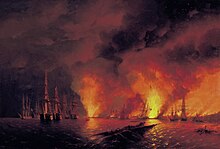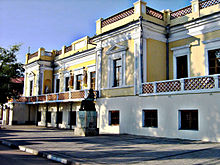Ivan Konstantinowitsch Aivazovsky


Ivan Konstantinovich Aivazovsky ( Armenian Հովհաննես Կոստանդինի Այվազովսկի , Russian Иван Константинович Айвазовский , scientific transliteration. Ivan Konstantinović Ajvazovskij ; born July 17 . Jul / 29. July 1817 greg. In Feodosia , Crimea , Russian Empire ; † April 19 jul. / 2 May 1900 greg. In Feodosia) was a Russian romantic painter of Armenian descent. His last name was also spelled Aiwazowsky in some works .
He dedicated a large part of his work to marine painting , in which his personal style was shown, among other things, in the virtuoso design of light and shadow, such as B. Light effects of water.
life and work
Aivazovsky came from an Armenian family, the orientalist Gawriil Aivazovsky was his brother.
Aivazovsky received his first art lessons from a family friend, the German-born architect Koch. This promoted him to the best of his ability and arranged for him the support of the city commandant of Feodosiya. When he was transferred to Simferopol , he took Aivazovsky with him and had him trained there at his own expense.
In Simferopol, Natalja Naryschkina, daughter of Count Fyodor Rostoptschin , became aware of Aivazovsky and gave him an apprenticeship in the studio of the court painter Salvatore Tonci in Moscow . There Aivazovsky met the painter Alexander Olenin , who - convinced of Aivazovsky's talent - successfully asked Tsar Nicholas I for permission to visit the Russian Academy of Arts .
With effect from August 23, 1833 Aivazovsky became a student of Maxim Vorobjow in the Academy of Saint Petersburg . At the personal request of Tsar Nicholas, the French marine painter Philippe Tanneur also became Aivazovski's teacher. This teacher-student relationship turned out to be extremely difficult from the start, since a. Tanneur pretended to be some of Aivazovsky's works as his own.
Aivazovsky received generous help and further support from the writer Wassili Schukowski and the history painter Alexander Sauerweid . In the latter's house, Aivazovsky met Admiral Konstantin Nikolajewitsch , who was very interested in Aivazovsky's works. During the summer of 1836, Aivazovsky was able to travel to Finland in the wake of Admiral and the Crimea the following year .
A generous travel grant from the Tsar's court enabled Aiwasowski to travel to Rome via Berlin, Dresden, Vienna, Trieste, Venice and Florence in 1839 to study the ancient masters. From there he traveled to Paris in 1840, where he was asked to take part in an exhibition at the Paris Salon. He returned to Rome in the spring of 1841 and visited London the following year, where he stayed for a few weeks. His return journey took him back to Rome via Lisbon and Madrid.
In 1844 Aivazovsky returned to St. Petersburg via Amsterdam. In Amsterdam, Aivazovsky was able to show his works at a first major solo exhibition and was awarded a gold medal by the Royal Academy of Fine Arts in Amsterdam. On the occasion of Aivazovsky's first audience with Tsar Nicholas I after his return, he was appointed painter of the naval staff, with the permission to wear the uniform of the Tsarist Navy. In the same year the St. Petersburg Academy of Art accepted Aivazovsky as a full member.
In 1846 Aivazovsky was again able to visit Constantinople in the wake of General Nikolajewitsch and from there to travel the country for a few weeks.
On the occasion of his thirtieth birthday, Aivazovsky was honored with the title of professor in 1847 . In that year he also settled in his hometown Feodosia, where he built a villa with a large studio.
Aivazovsky spent the winter of 1857/58 in Paris, where he was able to take part in a number of exhibitions. Empress Eugénie became aware of some of these works and purchased two of them. During this time Aivazovsky was accepted as a knight in the Legion of Honor . In the spring of 1858 he returned to Feodosia and lived there for the next twenty years, only interrupted by a few short trips: in 1867 he stayed in Constantinople and on November 16, 1869 he officially took part in the opening of the Suez Canal ; he was to record them in a monumental painting for the court of the tsars.
In 1873 there was a large solo exhibition of Aivazovsky's works in the Art Academy in Saint Petersburg; an almost identical exhibition took place in Nice in 1875 (staged by the local Russian community).
On the occasion of his 70th birthday in 1887, the St. Petersburg Art Academy made him an honorary member and also had a gold medal minted. In his acceptance speech, Aivazovsky mentioned 4,000 pictures that he had created so far.
From then on Aivazovsky lived secluded in his hometown, where he died on May 2, 1900 at the age of 82.
Works (selection)
- Moonlight landscape in the Crimea
- Sunrise in Venice
- Sunset on the Black Sea
- View of Kerch
- Sunrise over the sea
- Constantinople in the moonlight
- Coastal landscape in Italy
- Gulf of Naples (1841)
- The ninth wave (1850)
- The Battle of Sinope (1853)
- The creation of the world. 1864, State Russian Museum , Saint Petersburg
- The flood. 1864, State Russian Museum, Saint Petersburg
- North Sea storm. 1865, Aivazovsky Gallery , Feodosia, Crimea, Ukraine
- American ships at the Gibraltar Rock. 1873, privately owned (Christie's auction, London, June 2007)
- Battle of Tschesme (1881)
- The seashore . 1886.
- Coastal landscape in Italy. 1878, private collection (Koller auction, Zurich, September 19, 2008)
- The wave. 1889, State Russian Museum, Saint Petersburg.
- Ships off the Caucasian coast . 1889. (Koller auction, Munich 2015)
- Self portrait. 1889, Aivazovsky Gallery, Feodosia, Crimea, Ukraine
- The ship MARIA in the storm 1892
- Between the waves. 1898, Aivazovsky Gallery, Feodosia, Crimea, Ukraine.
exhibition
- 2011: Aivazovsky. Painter of the sea. Bank Austria Kunstforum , Vienna
literature
- Eduard Dobbert : Aiwasowski, Iwan Konstantinowitsch Aiwasoffski (also Gaiwasowski) . In: Julius Meyer (Ed.): General Artist Lexicon . 2nd, completely revised edition. tape 1 : Aa-Andreani . Wilhelm Engelmann, Leipzig 1872, p. 156–157 ( Textarchiv - Internet Archive - new edition of Nagler's artist lexicon).
- Wilhelm Neumann : Aiwasoffski (Gaiwasoffski), Iwan Konstantinowitsch . In: Ulrich Thieme , Felix Becker (Hrsg.): General Lexicon of Fine Artists from Antiquity to the Present . Founded by Ulrich Thieme and Felix Becker. tape 1 : Aa – Antonio de Miraguel . Wilhelm Engelmann, Leipzig 1907, p. 156–157 ( Text Archive - Internet Archive ).
- Nikolai Nowouspenski: Ivan Aivazovsky. Painter of the sea. Parkstone Press, Bournemouth, England 1995, ISBN 1-85995-214-3 .
- Ingried Brugger , Lisa Kreil (ed.): Aiwasowski - painter of the sea. Hatje Cantz, Ostfildern 2011, ISBN 978-3-7757-2781-5 .
Web links
- Literature by and about Iwan Konstantinowitsch Aiwasowski in the catalog of the German National Library
- Entry on Aivazovsky, Ivan in the Encyclopedia of Ukraine (English)
- History, exhibition, impressions and objects of the National Picture Gallery Feodosia "IK Aivazovsky" (Russian)
- Works by Iwan Konstantinowitsch Aiwasowski at Zeno.org .
- Information about the artist and his works (Russian)
- Article Iwan Konstantinowitsch Aiwasowski in the Great Soviet Encyclopedia (BSE) , 3rd edition 1969–1978 (Russian)
- Art Gallery Worldwide - Aivazovsky, Iwan Konstantinowitsch Biographies (Russian)
- Ivan Aivasovsky in the Artvibrations Archive ( Memento from December 17, 2013 in the Internet Archive )
- Video portrait of Aiwasowski retrospective Bank Austria Kunstforum , CastYourArt, Vienna 2011.
Footnotes
- ↑ Swantje Karich: Iwan Aiwasowski in Vienna: Shipwreck in the sunset. In: Frankfurter Allgemeine Sonntagszeitung . April 24, 2011, p. 55 ( faz.net ).
| personal data | |
|---|---|
| SURNAME | Aivazovsky, Ivan Konstantinovich |
| ALTERNATIVE NAMES | Айвазовский, Иван Константинович (Russian); Ajvazovskij, Ivan Konstantinovič |
| BRIEF DESCRIPTION | Russian marine painter |
| DATE OF BIRTH | July 29, 1817 |
| PLACE OF BIRTH | Feodosia |
| DATE OF DEATH | May 2, 1900 |
| Place of death | Feodosia |


